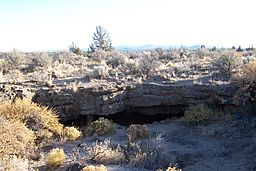Horse Lava Tube System facts for kids
Quick facts for kids Horse Lava Tube System |
|
|---|---|

Vulture Cave of the Horse Lava Tube System
|
|
| Location | Deschutes County, Oregon, United States |
| Geology | Horse Cave lobe; basalt of Lava Top Butte |
| Difficulty | Easy to Moderate |
| Access | Varied |
| Cave survey | Ongoing |
The Horse Lava Tube System is an amazing network of underground tunnels in Deschutes County, Oregon, Oregon, United States. These tunnels are actually lava tubes, which are natural caves formed by flowing lava.
This system starts in the Deschutes National Forest, near the Newberry Volcano. It stretches north towards the city of Bend and even further to Redmond, where the Redmond Caves are found. The lava flow that created these caves is called the Horse Cave lobe. It's about 80,000 years old! This ancient lava flow even filled an old path of the Deschutes River.
Contents
Discovering the Horse Lava Tubes
The Horse Lava Tube System got its name from Ronald Greeley of NASA. He was studying lava tubes for the Oregon Department of Geology and Mineral Industries. He named the whole system after the first well-known cave in it: Horse Cave.
Horse Cave was found in the early 1900s by some cowboys. They were looking for lost cattle when they stumbled upon the cave. As they approached, they scared some horses that were hiding inside the entrance!
However, the very first caves in this area that people knew about might have been the Redmond Caves. An old stagecoach road passed by them in the 1870s. Even before that, many of these caves were known to Native Americans. We know this because ancient tools and other items have been found inside.
Protecting the Caves
Today, different groups own and manage the caves in the Horse system. Some are on private land, while others are managed by the city of Bend or the Bureau of Land Management. Because of this, the caves face different challenges. Some have been covered up, and sadly, others have seen more vandalism.
The biggest threat to these caves is new buildings and towns. As the city of Bend grows, it expands into areas where these caves are located. When private companies buy this land, the future of the caves can be uncertain.
To help protect these natural wonders, a group called the Oregon High Desert Grotto works with landowners and the state. In 1995, they helped clean up the Horse Caves, removing lots of trash. Even though more trash appeared later, they kept working. In 1997, they did more cleanups with help from local news, other caving groups, and high school students. They successfully removed garbage and even scrubbed graffiti from the cave walls.
More recently, from 2006 to 2007, members of the Grotto worked with the Department of State Lands. They explored and mapped 8 caves on state land. They also gave advice on how to manage the caves and protect the bats that live there. In 2008, the Grotto received an award for their amazing volunteer work!
Types of Caves in the System
There are 122 known caves in the Horse Lava Tube System. They range from very small to very large. If you could walk through all the known passages, it would be over 22,000 feet long! Most of these caves are on private property, so only a few are well-known to the public. Some popular ones include The Horse Caves, The Redmond Caves, Stevens Cave, Lewis Farm Cave no. 1, and Youngs Cave.
Spatter Cone Caves
These caves are found right where the lava first erupted. They are usually small and short tunnels or bubble-like cavities near the surface. Most of them are only a foot or two underground. There are about 40 of these small spatter cone caves.
Rootless Vent Caves
A small group of caves similar to spatter cone caves are located just north of the main eruption area. They are called "rootless vent caves" because they aren't directly on the lava's source. They look very much like spatter cone caves. About 19 rootless vent caves are part of the Horse system.
Lava Tube Caves
The main caves of the Horse system are the lava tubes. About 63 lava tubes are known so far. Some are quite short, around 20 feet long. The longest one has three parallel passages and is almost 4,000 feet long! There might be even more undiscovered lava tubes, as some may not have natural entrances, or their entrances might have been filled in over time.
Other Caves
A few other types of caves exist in the system. These are mostly "surface tubes," which are small tunnels very close to the ground's surface. A couple are also simple shelters or "talus caves," formed by rocks piling up.

